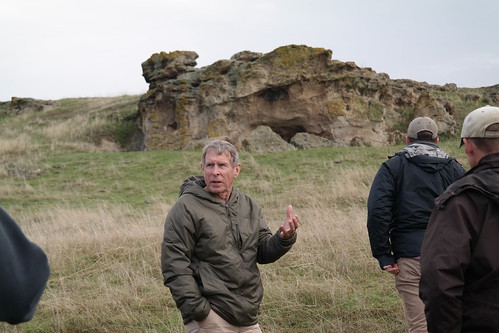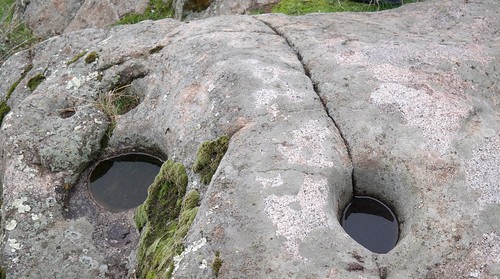
The day was brisk, the air was fresh, and the subject of the day was captivating. Sixteen Natural Resources Conservation Service (NRCS) field conservationists in California had just sat through a day of classroom-style instruction on cultural resources policy, law and identification. Now they trudged along behind California State Archaeologist Ben Barnette to practice their skills in a field setting.
“It all seemed fairly ordinary,” said Soil Conservationist Chris Robbins. “We stopped at a ranch and hiked over to an unremarkable rock formation jutting from the rolling landscape. But it turned out to be a rock shelter that was used by Native Americans—with plenty of evidence to prove it. They left their marks on the walls as well as pieces of artifacts scattered nearby.”
Barnette says students new to cultural resources often have Robbins’ reaction. “If they just have the book portion of the training it’s rather ho hum,” says Barnette. “Then they get out on a piece of land and it’s clarified for them. It becomes exciting. They realize people lived here—right here—hundreds or thousands of years ago.” Barnette says this realization naturally leads people to ask: ‘What were they doing here?’
And archeology proceeds from there, he says.

These messages from past peoples are remarkable cultural treasures—despite sometimes being found in fairly unremarkable settings. Knowing where the treasures are is the first step in protecting them. That’s why NRCS and other federal agencies are required to do cultural resource surveys before undertaking work on the land, as explained in the Historic Preservation Act of 1966.
In California, NRCS does this work in consultation with the State Historic Preservation Office, or SHPO. Areas that haven’t already been surveyed—or that have been made exempt for various reasons—are surveyed by one of NRCS’ four archeologists. Conservationists, like Robbins, are now getting the chance to do small (less than 20 acres) surveys. After two days of training the recruits can become certified as cultural resource technicians.
The Orvis Cattle Company ranch where Robbins’ training took place has hosted NRCS cultural resource trainings for decades, says District Conservationist Diana Waller. “They have also allowed our soil surveyors to dig pits there, and they have covered the ranch with an easement —partially funded by NRCS—that will keep these treasures protected into perpetuity.”
“Our family has always protected these sites,” says Don Harper, partner of Orvis Cattle Co. “We realize the worth of these wonderful places, and we have welcomed NRCS, universities and other entities to study here in the past.”
Robbins continues to describe his training experience: “The past people on the site left shards of chert that pierced the damp soil surrounding the rock overhang. It was like they had left us a clue to at least one of the activities they did at this site. They made tools here. We do not know if there were projectile points or knives or scrapers, but the fact was that the tools were evidence of their presence, left behind for us to find, hundreds, maybe thousands of years later.”
Several hundred years after the Native Americans left chert tools and petroglyphs on the site, another culture visited with a rather different purpose in mind: Hollywood used the hillside to film the pilot episode and opening sequence of The Little House on the Prairie. Barnette says that as he shared this information with the class they all fired up their iPhones to immediately compare their surroundings to the show on YouTube.
In California, NRCS has trained dozens of cultural resource technicians in the last five years. It helps to balance the archeology workload and many employees like Robbins find it adds an unexpectedly exciting element to their job. “I look forward to using this knowledge to conduct cultural resources surveys,” he says, “and I know I will use it when hiking and exploring with my family.”
“We owe a debt of gratitude to families like the Harpers,” says Barnette. “It makes it possible to spread this knowledge to young people like Robbins who can help us protect similar sites across California and the Nation.”

